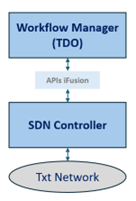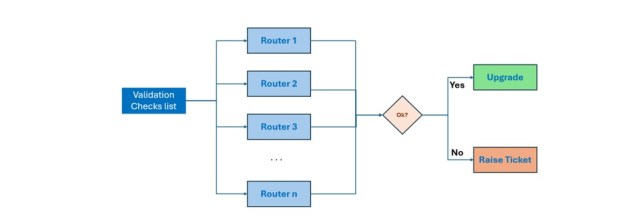The Autonomous Network Journey Program (ANJ) by Telefónica, sponsored by GCTIO, aims to transform processes to enhance automation and autonomy in the networks. This transformation is driven by various initiatives and use cases across all the group’s Operational Business (OB). These initiatives focus on reducing manual tasks and automating activities within different network domains (CORE, RAN, IP, Optical, MW). To elevate network autonomy, it is crucial to adopt key concepts such as Artificial Intelligence (AI), intents, closed-loop, AIOps…
Another critical concept in advancing network autonomy is network disaggregation. By exposing open and standard, vendor-abstract APIs in the SDN iFusion controller within Telefónica’s transport network and implementing open interfaces that facilitate communication between network elements and domain controllers, it is possible to define and execute use cases developed within a transport domain workflow.
This environment operates in the Domain Orchestrator, where a dedicated instance for the transport domain has been developed. Within this instance, various scenarios for integrating the SDN controller can be defined. Using this Workflow Manager for the transport domain (IP, optical and MW) opens up numerous opportunities for developing network automations.
This architecture is standardized and based on transport network information. A key aspect of this architecture is its uniformity across the entire Group, facilitating the definition and implementation of similar use cases across all the OBs.
Implementation of a Workflow Manager environment for the transport network
Building on this premise, O2 Germany has deployed a production environment for developing automation use cases for the transport network, based on workflow definitions and their integration with the SDN controller. This Workflow Manager, Transport Domain Orchestrator, enables the massive automatic verification of the parameters of the IP network equipment and service provisioning, among other UCs. Based on the idea of intent, defined by TM Forum as the action to communicate requirements, goals or tasks to an autonomous system, this workflow can connect to the iFusion APIs, and make possible to orchestrate actions directly into the network orchestrator by applying a closed-loop, and execute different tasks applied automatically in the elements of the transport network.

1. Workflow architecture
The IP network contains a large number of devices, which can be challenging to manage manually. One example of this complexity is the software upgrade process, where it is necessary to verify before executing it, that all devices are in the correct state to avoid any service disruption during the upgrade.
In this context, O2 Germany has developed an initial use case, which involves a workflow for the IP router version upgrade process. This workflow includes a series of Pre and Post Upgrade checks to verify the state of the network devices before and after the upgrade.
Why to check the status of devices before the upgrade?
In the transport network, it is essential to keep devices updated and to perform these updates without service interruptions. It is necessary to check the state of the routers in the IP network to ensure that the upgrade can be executed without affecting the device’s performance or causing any network or customer impact.
To achieve this, a checklist has been established, which was previously performed manually. This checklist includes the verification of various device parameters, such as ensuring the device has the latest software version installed, enough memory, active alarms…

2. Scheme for the check validation workflow
Once the checks have been validated and the status of each device has been verified, the automatic decision is made on whether a router can be upgraded or not. If, for any reason, the upgrade cannot be performed due to a failed check, an issue raised to communicate this status.
Implementing this workflow brings quality and agility to the upgrade process
Some of the benefits that the operation engineers found when this workflow is applied into the process are:
- Detect risks before and after applying changes in the transport network.
- Automate go/no-go decisions.
- Speed up the troubleshooting in the upgrade process.
- Scale to new UC like service provisioning, automated software upgrades, devices acceptance, etc.
Today, the status checks are performed for devices from a single vendor within the network, but it is anticipated that by the end of this year, the workflow will be applicable to devices from other manufacturers. The number of devices from this first provider, close to 10.000, is verified in a short time, saving around 800 hours of manual work, and going from a rudimentary manual check, where sometimes some errors occurred, to an automatic process, minimizing these errors and the impact after the software upgrade, bringing high quality and agility to the process. It is expected that in the coming months automatic upgrades based on checks results will be included in the workflow, by implementing a closed-loop process for transport network device upgrades.
The implementation of this workflow is an important driver for the design and development of automation use cases. This initial use case is just the beginning, and more cases are expected to be developed over the coming months. There are ambitious plans to continue advancing in this direction and increasing automation within the transport network. This will enhance the autonomy of various activities within Telefónica Germany’s transport network processes, moving closer to the Level 4 of Autonomy defined by the TM Forum, which is one of the Telefonica’s goals for 2025, to achieve Level 4 in some of their processes.








